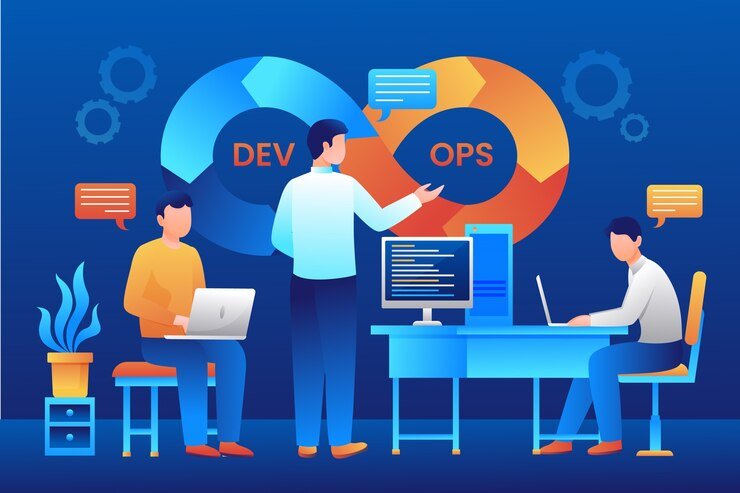Navigating the Business Computing World: Trends, Tools, and Techniques

Introduction to Business Computing
The business computing world has undergone significant transformations over the past few decades, evolving from traditional methodologies to the sophisticated digital strategies prevalent today. At its core, business computing encompasses the technologies and processes that organizations use to manage, analyze, and leverage data for decision-making and operational efficiency. It plays a crucial role in addressing the complexities inherent in modern-day businesses, providing foundational support to both large enterprises and small startups alike.
Traditionally, business computing involved basic data storage and processing, typically executed through standalone machines and rudimentary software applications. As the demand for efficiency and speed in operations grew, businesses began to embrace more integrated systems. This included the transition to networked computing environments that facilitated collaboration and cross-departmental data sharing. The advent of cloud computing further propelled this evolution, allowing businesses to store and access data remotely, thereby fostering real-time collaboration and enhancing data accessibility.
In recent years, the rise of advanced technologies such as artificial intelligence, machine learning, and big data analytics has reshaped the landscape of the business computing world. Organizations are now equipped to harness vast amounts of data to unveil insights that drive innovation and competitive advantage. This rapid pace of technological advancement has also led to a greater emphasis on cybersecurity, ensuring that sensitive information remains protected from increasingly sophisticated threats.
As organizations continue to adapt to these changes, understanding the key components that define the modern business computing environment becomes imperative. Recognizing the tools and techniques available to leverage data effectively, optimize processes, and enhance productivity will empower businesses to navigate the complexities of today’s market successfully. Ultimately, a thorough comprehension of business computing is essential for enterprises aiming to thrive in an increasingly interconnected and data-driven landscape.
Current Trends in Business Computing
The business computing world is rapidly evolving, driven by a myriad of technological advancements and trends that enhance both operational efficiency and decision-making capabilities within organizations. One of the most significant trends is cloud computing, which has revolutionized how businesses store, manage, and access data. By utilizing cloud-based solutions, companies can significantly reduce hardware costs, improve flexibility, and ensure scalable solutions that adapt to changing business needs. This shift towards the cloud allows for easier data collaboration and real-time access to information, facilitating a more agile approach to business operations.
Another crucial trend is the integration of artificial intelligence (AI) into business processes. AI technologies enable organizations to automate routine tasks, streamline complex workflows, and enhance customer experiences. Machine learning, a subset of AI, empowers systems to learn from data and improve over time, allowing businesses to derive insights from vast amounts of information. With the increasing availability of advanced machine learning algorithms, businesses are now able to make data-driven decisions with greater accuracy, ultimately leading to improved productivity and efficiency.
Furthermore, big data analytics has become an essential component of the business computing landscape. Companies harness large volumes of data generated from various sources to identify trends, predict outcomes, and make informed decisions. By utilizing sophisticated analytics tools, organizations can tailor their strategies to better meet customer demands and optimize their operations. This trend highlights the growing importance of data literacy and the need for professionals skilled in navigating the complexities of data analysis.
As these trends continue to evolve, they will undoubtedly reshape the business computing world, presenting new challenges and opportunities for organizations seeking to leverage technology effectively. Understanding and adapting to these developments will be crucial for companies aiming to maintain a competitive edge in their respective industries.
Essential Tools for Modern Businesses
In the ever-evolving business computing world, having the right tools at one’s disposal is crucial for enhancing productivity and driving success. Various software solutions have emerged as essential components that streamline operations, promote collaboration, and leverage data to inform decisions. This section will delve into several key categories of tools essential for contemporary businesses.
First, project management software has become indispensable in maintaining organization and ensuring deadlines are met. Tools such as Asana, Trello, and Monday.com enable teams to assign tasks, track progress, and collaborate in real-time. These platforms not only improve transparency but also allow managers to allocate resources effectively, reducing bottlenecks in operations and increasing overall efficiency.
Another critical component in today’s business landscape is Customer Relationship Management (CRM) systems. Platforms like Salesforce and HubSpot serve to centralize customer interactions, helping businesses manage relationships and data throughout the customer lifecycle. By facilitating communication and maximizing customer engagement, CRM systems contribute significantly to improving sales strategies and boosting customer satisfaction.
Furthermore, effective communication is vital for any business, particularly in today’s remote working environment. Tools such as Slack, Microsoft Teams, and Zoom provide robust platforms for team collaboration, allowing for seamless messaging, video calls, and file sharing. These platforms not only foster more effective communication but also enhance teamwork across disparate locations, a necessity in the current business computing world.
Lastly, data analytics tools such as Tableau and Google Analytics are transforming how businesses understand their performance and customer behavior. These tools offer crucial insights and visualization capabilities, enabling organizations to make data-driven decisions that can enhance operational efficiency and competitive advantage.
Overall, integrating these essential tools into a business’s workflow is imperative for remaining competitive and achieving long-term success in the rapidly changing business computing environment.
The Role of Cybersecurity in Business Computing
In the dynamic landscape of the business computing world, cybersecurity plays an indispensable role in safeguarding sensitive information and maintaining operational integrity. Organizations today face an array of potential threats, ranging from sophisticated cyberattacks to insider breaches. These threats can disrupt operations, lead to financial losses, and damage reputations. The rise of remote work and digital transformation initiatives has further amplified the need for robust cybersecurity measures, as businesses must protect their digital assets from a growing number of vulnerabilities.
To mitigate these risks, organizations should adopt best practices for securing their sensitive data. Implementing multi-factor authentication, conducting regular security audits, and utilizing encryption techniques are vital steps that can significantly enhance the security posture of a business. Additionally, organizations should prioritize the use of firewalls and intrusion detection systems to thwart unauthorized access to their networks. These tools serve as the first line of defense against cyber threats, ensuring that only authorized users can access critical business information.
However, technology alone cannot ensure comprehensive protection. Building a culture of cybersecurity awareness among employees is equally crucial. Conducting regular training sessions can equip staff with the knowledge to recognize phishing scams, ransomware threats, and other malicious activities. Employees must be encouraged to adhere to security protocols, report suspicious activities, and understand their role in safeguarding the organization’s information. Creating an environment where cybersecurity is a shared responsibility fosters vigilance and enhances the overall resilience of the business against potential cyber threats.
Ultimately, navigating the business computing world requires a proactive approach to cybersecurity. By employing a combination of technological solutions and fostering a culture of awareness, organizations can protect their assets, preserve customer trust, and maintain their competitive edge in an increasingly complex digital environment.
Integrating Emerging Technologies
As organizations navigate the rapidly evolving landscape of the business computing world, the integration of emerging technologies has become essential for enhancing operational efficiency and maintaining competitive advantage. Technologies such as blockchain, the Internet of Things (IoT), and augmented reality present both opportunities and challenges for businesses aiming to optimize their processes and services.
Blockchain technology, known for its security and transparency, can transform supply chain operations by providing a decentralized record of transactions. This promotes trust among stakeholders while minimizing fraud and errors. However, integrating blockchain requires substantial expertise and a thorough understanding of its implications across business functions. Organizations must also consider regulatory compliance and data governance to successfully implement this technology.
The Internet of Things (IoT) is another transformative force within the business computing world. By connecting devices and systems, IoT facilitates real-time data collection and analytics, enabling businesses to make informed decisions quickly. Nevertheless, the integration of IoT systems can pose challenges, such as security vulnerabilities and the need for a strong infrastructure capable of managing vast amounts of data. Companies looking to harness the power of IoT must focus on developing secure networks and suitable data management solutions to overcome these obstacles.
Augmented reality (AR) is rapidly gaining traction in sectors like retail and training, enhancing customer experiences and learning through immersive interactions. Integrating AR into existing systems demands careful planning, as businesses must align technology with strategic goals while ensuring that staff are adequately trained to leverage these tools effectively. Organizations should prioritize user-centric design to maximize the impact of AR technology.
In conclusion, successful integration of these emerging technologies requires not only infrastructural investment but also a strong emphasis on training and strategic alignment. By embracing the challenges and opportunities presented by blockchain, IoT, and AR, businesses can position themselves to thrive in the dynamic business computing world.
Enhancing Collaboration Through Technology
In today’s business computing world, collaboration has become increasingly essential for organizations aiming to enhance efficiency and innovation. The advent of various collaborative tools has transformed how teams interact, breaking down geographical barriers and enabling seamless communication. Platforms such as Microsoft Teams, Slack, and Asana provide virtual spaces where team members can share ideas, allocate tasks, and employ project management techniques to keep projects on track.
Remote work technologies have further refined collaboration, particularly in light of the recent global shift towards hybrid and remote working models. Video conferencing tools like Zoom and Google Meet allow teams to hold meetings regardless of physical distance, fostering face-to-face interaction that is critical for brainstorming and decision-making. With the integration of screen sharing and collaboration features, these tools empower teams to work together effectively, regardless of their location.
Furthermore, the impact of sharing platforms has become increasingly prominent in the business computing world. Cloud-based services such as Google Drive and Dropbox enable easy access to documents and files, allowing for real-time collaboration. These platforms not only enhance productivity by providing easy retrieval of shared resources but also promote innovation by facilitating diverse input from team members with varied perspectives. By leveraging such technologies, organizations can harness the full potential of their human capital, leading to quicker problem resolution and creative solutions.
In summary, the integration of collaborative tools and remote work technologies plays a vital role in enhancing teamwork and driving productivity. As organizations continue to adapt to the evolving business computing world, embracing these technologies will be paramount in fostering a culture of collaboration conducive to achieving strategic objectives.
Measuring Success in Business Computing
In the rapidly evolving business computing world, measuring success has become essential for organizations seeking to enhance their performance and strategic direction. Key Performance Indicators (KPIs) and strategic metrics serve as vital tools for evaluating the effectiveness of computing strategies. These indicators help businesses quantify their objectives, leading to clearer insights into operational efficiency and success.
Common KPIs in the context of business computing may include metrics such as system uptime, user satisfaction ratings, and efficiency of resource allocation. System uptime reflects reliability and ensures minimal disruption, which can significantly impact overall productivity. Similarly, user satisfaction ratings gauge how well computing resources meet user expectations, providing critical feedback that can guide future improvements in system design. Resource allocation efficiency, on the other hand, offers insight into how effectively the business is utilizing its computing resources, thereby highlighting areas requiring enhancement.
Data-driven insights are crucial in the business computing realm, as they empower organizations to make informed decisions based on real-time data analysis. By closely monitoring KPIs and metrics, businesses can identify trends and patterns that inform strategic changes. For instance, if a particular system component is consistently underperforming, businesses can allocate resources to upgrade or replace it, thus optimizing their computing environment. This continuous cycle of measuring and adjusting ultimately fosters an environment of ongoing improvement.
Moreover, establishing a culture of data analytics within the organization encourages teams to leverage insights for smarter decision-making. When employees across various levels are empowered with data-driven information, they are more equipped to contribute to the organization’s overall success in the business computing world. This collaborative approach not only enhances performance but also supports a more agile and responsive organizational structure, crucial for thriving in today’s competitive landscape.
Future of Business Computing
As we examine the trajectory of the business computing world, it becomes increasingly evident that emerging technologies will play a significant role in reshaping operational frameworks and business models. Notably, advancements in artificial intelligence (AI) are set to revolutionize the efficiency and potential of various industries. AI and machine learning algorithms can analyze vast datasets at unprecedented speeds, enabling businesses to derive insights that inform strategic decision-making and enhance customer engagement through personalized experiences.
In addition to AI, another groundbreaking technology on the horizon is quantum computing. Unlike classical computing, which processes information in binary, quantum computing leverages the principles of quantum mechanics to perform complex calculations rapidly. This capability holds the potential to solve problems that are currently intractable for classical machines, such as optimization challenges in supply chain management or simulating molecular interactions for drug discovery. As a result, businesses may achieve unparalleled operational efficiency, ultimately leading to innovation in products and services.
Furthermore, the integration of cloud computing continues to evolve, improving access to resources and data analytics tools across the business computing landscape. The scalability of cloud solutions allows organizations to manage computing power dynamically, adapting to fluctuating demands without significant capital investment. This flexibility supports remote work, enables collaboration across geographies, and enhances operational resilience.
Lastly, cybersecurity remains a top priority as businesses increasingly rely on digital tools. As cyber threats become more sophisticated, investing in robust security frameworks will be essential to protect sensitive information and maintain consumer trust. The future landscape of the business computing world will undoubtedly be shaped by these innovations, driving a shift toward more agile, data-driven decisions and a commitment to securing digital assets.
Conclusion: Embracing Change in Business Computing
As we have explored throughout this blog post, the landscape of the business computing world is continually evolving, driven by technological advancements and shifting market needs. Key trends such as cloud computing, artificial intelligence, and data analytics are shaping how organizations operate, enabling them to become more efficient, agile, and customer-centric. The tools and techniques available to businesses today are far more advanced than ever before, offering enhanced capabilities that can transform operations across various sectors.
Adaptability emerges as a crucial trait for businesses looking to thrive in this dynamic environment. The ability to embrace new technologies and integrate innovative solutions into existing workflows can provide a competitive edge. Companies that resist change risk falling behind, as they may not fully utilize the vast possibilities offered by modern business computing. Therefore, fostering a culture of innovation, where employees are encouraged to explore new ideas and methods, is essential for sustained growth and success.
Moreover, investing in continuous education and professional development for employees is vital. As the business computing world grows ever more complex, upskilling staff to navigate these changes ensures that organizations can effectively leverage emerging technologies. By doing so, companies can not only improve their operational efficiencies but also enhance their strategic decision-making capabilities.
In conclusion, embracing change in the business computing world is not merely an option; it is a necessity for long-term success. As we look to the future, organizations must remain vigilant and open to the advancements that technology brings. By actively engaging with these developments and adapting their strategies accordingly, businesses can position themselves to thrive amid ongoing transformation and seize new opportunities as they arise.




